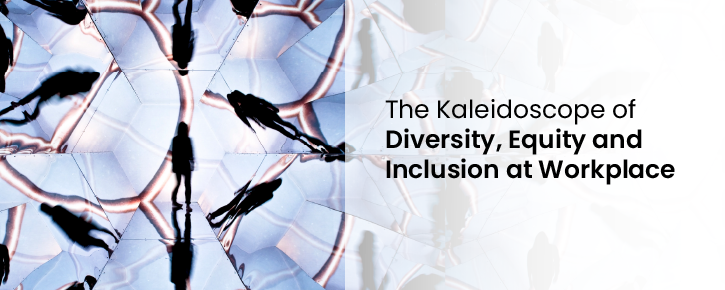A kaleidoscope is always intriguing. As a child, I was captivated by the array of diverse, colourful designs. Unaware of the workings of a kaleidoscope, it remained magical and mysterious until the science was explained to me. Did the explanation ruin the magic? I would say no.
The kaleidoscope of diversity at workplace has its own charm and positive energy. Recently we had a riveting conversation with Mr. Manoj Chandran, Head of Marketing at Manah Wellness, a dedicated enterprise fostering mental wellbeing and encouraging diversity and inclusion in businesses. We delved a lot into understanding the current state and challenges in building and enabling a diverse culture and explored simple and clear actions to create a safe and secure place for employees irrespective of class, caste, gender, race, region or religion. Here are some nuggets from our conversation, exploring the journey of building a conducive environment that internalizes diversity, equity and inclusion, beyond vision statements and vanity metrics.
Diversity at workplace
In modern workplaces, diversity is generally viewed as hiring people from various backgrounds, including age, gender, race, religion, ability, ethnicity, identity, cultural background, and more. Yet, diversity is more than hiring a diverse workforce. It is scanning the nook and crannies of your organization, to assess the enabling culture that celebrates each employee for what they are. Leaders need to be cognizant to address biases and discrimination. It is important to delve into some fundamental questions – does everyone feel heard and accepted? Do they feel safe to voice their ideas and thoughts?
Inclusion and equity, and the game of numbers
Diversity Equity and Inclusion (DE&I) is the buzzword today. Employers across industries and geographies are making pledges to build a diverse work environment. In recent times, to narrow the gender bias organizations are trying to hire more female employees, though the rise upward to them rather steep. The number of women in leadership position is far less than their male counterparts, and that is where the math stumbles. Creating a diverse pool of employees and providing a level playing field of equal opportunities is easier said than done. However, the businesses that are able to build a culture of diversity and inclusion across organizations are reaping great dividends. They are not just a preferred workplace among prospective employees and respected partners for their customers but also gain higher revenue thanks to enhanced productivity of their workforce. Inclusiveness extends to diversity at every level in the organization. As Mr. Chandran says, “It makes perfect business sense for organizations to focus on diversity and make sure that workplaces are inclusive enough and have all the right ingredients for every single identity to thrive and feel safe in their workplaces.”
Safe and enabling workplace, where employees feel at home
Building a diverse culture goes beyond vision statement. A happy workplace is the sum of intent and enabling ecosystem of trust and bonding. Consistent stress and toxic environment at work impacts efficiency. Recent research from Strategic Human Resource Management found that 1 out of 4 employees dread going to work and are not respected and/or valued in the context of diversity and inclusion. The impact is directly proportionate to revenue generated by businesses. New data shows that American businesses lost $223 billion over the last five years due to bad culture at workplace. “Billions of wasted dollars. Millions of miserable people. It’s not a warzone—it’s the state of the American workplace,” said SHRM president and CEO Johnny C. Taylor, Jr., SHRM-SCP. “Toxicity itself isn’t new. But now that we know the high costs and how managers can make workplaces better, there’s no excuse for inaction.” (https://www.shrm.org/) Mr. Chandran echoed the same concerns.
According to him, safety becomes a work culture not just a temporary initiative. Businesses must focus on employee talent, the reason they hired him/her in the first place, not their race, ethnicity or other diverse factors. Each employee deserves the opportunity to be their best.
Open culture that promotes mental wellbeing
Most of the time intent to foster diversity and equity right to the last one in line, fizzles midway. These scenarios take a toll on the mental well-being of employees. Being called out for their dressing or eating habits, for instance, is generally taken in lighter vein, but it leaves a negative impact. The mandate for true diversity, equity and inclusion is set from the top and with demonstrated leadership. As Mr. Chandran said, “leaders must provide an environment where employees are psychologically safe. But harnessing diversity is not a day’s work. It starts with mindset shifts at top level and is built upon by everyone in the company as they take it forward together” …
Diverse and equitable ecosystem, reaping rich dividends
A diverse workforce begets ideas, perceptions, knowledge, and experiences that positively and progressively enhance productivity, profit and the company’s image. A substantial amount of research has shown that diversity leads to increased revenue, availability of diverse skills, access to various ideas and provides a more significant competitive edge. When a company embraces diversity in management it positively affects the goodwill of the company in the eyes of its customers and prospective employees too.
Most organizations have a blueprint to create a cohesive and collaborative workforce. But the mosaic is yet to be laid out as a systemic design. The kaleidoscope of a diverse, inclusive and equitable workplace is shaping up, slowly but steadily. It may be not far that diversity is completely celebrated and instantly becoming a part of work cultures around the world.
To follow the complete conversation, check out StoryTalkies with Manoj Chandran.


